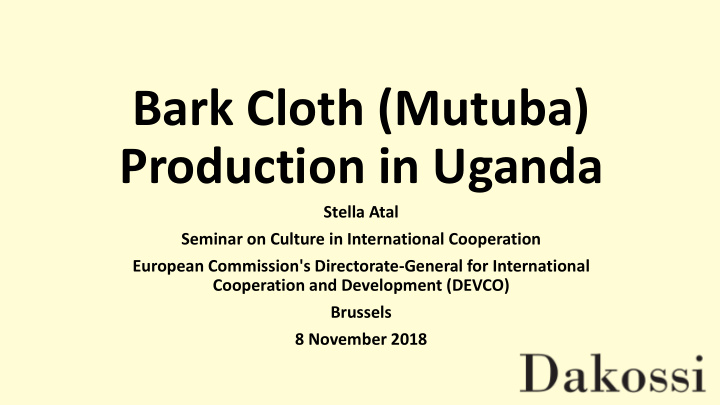



Bark Cloth (Mutuba) Production in Uganda Stella Atal Seminar on Culture in International Cooperation European Commission's Directorate-General for International Cooperation and Development (DEVCO) Brussels 8 November 2018
Bark Cloth Commonly known in central Uganda as Mutuba, bark cloth is produced from an indigenous fig tree and has traditionally been utilized to produce fabric for clothing and ornamental use. The Mutuba tree is fire resistant and widely used as a boundary marker across much of Uganda. It is also commonly used as a shade tree for coffee plantations.
Bark Cloth Harvesting The bark cloth is prepared by hand using traditional methods. The production process is time consuming and labour intensive providing community members with an income generating opportunity. After harvesting the bark from the tree and boiling, the bark is then processed.
Bark Cloth Preparation There are five separate steps involved in the process to prepare the bark cloth. Each of the steps involve beating the bark in a particular way using a variety of different sized and different shaped hand crafted wooden mallets.
Black Dye The bark cloth can also be died using a special method burying it in the mud. Over several days the chemicals in the mud react to the bark cloth to produce a permanent rich black colour before it is uncovered and thoroughly washed.
Mutuba Trees The mutuba trees used to produce bark cloth are very common across much of Uganda. The trees take 3-4 years before they can be harvested and the bark can be harvested from each tree once a year.
Production Constraints The main constraint to increasing bark cloth production is not the number of trees, but the limited number of craftsmen with the skills to make the cloth. The Bukomansimbi Organic Tree Farmers Association (BOTFA) Centre in Masaka in central Uganda is now training young people with the skills to produce bark cloth, but the demand remains limited to the local market.
Increasing Demand Dakossi is a new fashion label launched this week in Paris at the Africa Fashion Reception organized by Legendary Gold Limited and in collaboration with the African Union and UNESCO utilizing bark cloth procured from the BOTFA Centre in Masaka.
Collection Dakossi produces high quality hand crafted fashionable waistcoats made in Uganda with cow horn buttons. The waistcoats have been styled for men and women and are available in a variety of sizes.
Natural Materials Dakossi products are all hand crafted using traditional methods with minimal use of machines. While the highest quality standards are ensured through strict quality control. All the products are made and assembled from natural materials comprising bark cloth, cow horn, cotton and linen. The buttons for the waistcoats are all individually hand crafted from the cow horn of Ankole-Watusi Longhorn cattle indigenous to western Uganda.
Hand Crafted The cloth to be used for the Dakossi waistcoats is carefully selected. The bark cloth is cut into the appropriate shapes and sizes and the garments are sown together. The tailoring is outsourced to highly skilled tailors living in Kampala and subject to strict quality control measure to ensure high quality products.
Productive Use of Labour The majority of tailors engaged by Dakossi for this work are refugees from the Democratic Republic of Congo (DRC) now living in Uganda. Many are awaiting translocation to Europe or North America in search of work and better lives.
Objectives of Dakossi Dakossi is fully registered and incorporated in Uganda and was founded in June 2018 and the objectives of the company are: 1) To produce stylish high quality fashion items in Uganda, 2) Promote production in Uganda and contribute to the equitable and sustainable development of the country, 3) Share Africa’s cultural heritage with the world, and 4) Contribute to the rebranding of Africa.
Africa’s Future… Dakossi wishes to demonstrate that Africa has the capacity to produce fashionable garments and accessories to the highest international standards.
Thank You! Stella Atal Tel: +33 601142904 E-mail: S.Atal@dakossi.com Website: www.Dakossi.com
Recommend
More recommend